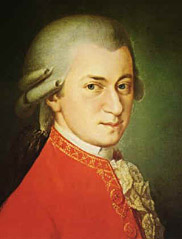|

| |
Oil painting by Barbara Krafft, Salzburg, 1819.
| |
|
|
|
Mozart’s masonic music
Mozart’s masonic music falls into three broad categories: music he wrote specifically for the lodge, music intended for the public but built on masonic themes, and music he wrote for other purposes, but which was adapted, either by himself or others, for masonic use.
K.53 Lied: An die Freude. Masonic poem set to music.
K.93 Psalm 129: De Profundis Clamavi for mixed choir and orchestra. Composed in Salzburg in 1771 and later adapted to masonic use by the composer.
K.148 O Heiliges Band (The hallowed bond of friendship) for tenor and piano. Composed in 1772 and adopted for Freemasonry; probably sung at refreshment
K.273 Graduale ad Festum B.M.V.: "Sancta Maria, mater Die for mixed choir and orchestra. Composed in 1777 and later adopted by the lodge.
K. 345 Thamos, Thamos Konig in Agypten (King of Egypt). Drama by Tobias Philipp Baron von Gebler (1773, revised 1779) Mozart’s incidental music themes are claimed to be heavily masonic.
K.410 Canonic Adagio for 2 bassett horns and bassoon. Composed in 1784, ritual procession music.
K.411 Adagio for 2 Clarinets and 3 Bassett Horns. (Probably intended as a processional entrance for the lodge.
K.429 Cantata: Dir, Seele des Weltalls. Composed for a public masonic celebration.
K.468 Gesellenreise. (Fellow Craft’s Journey) Bro. Franz Joseph v. Ratschky’s verse on the journey to greater knowledge, first performed in Lodge True Concord on 16 April 1785 for Mozart’s father’s Fellowcraft Degree.
K.471 Cantata: Die Maurerfreude (Masonic Joy). Words by Franz Petran, composed on 20 April 1785 and first performed in Lodge Zur gerkronten Hoffnung (Lodge Crowned Hope) on 24 April 1785 to honor Ignaz von Born, Grand Master of the United Lodges.
K.477 Maurerische Trauermusik (Masonic Funeral Music). Composed in Vienna on 10 November 1785 for a Lodge of Sorrows held by Lodge Crowned Hope a week later for the funerals of Bro. Georg August, Duke of Mecklenburg-Streletz and Bro. Franz, Count Esterhazy of Galantha.
K.482 Piano Concerto in Eb Major. Written for and performed at a concert given by the Lodge Zur gekronten Hoffnung, 15 December 1785.
K.483 Zerfließet heut', geliebte Brüder. Composed in December of 1785 for Lodge Crowned Hope. Text by Bro. Augustin Veith Edler von Schittlersberg, Senior Warden of Lodge True Concord for the opening of a lodge.
K.484 Ihr unsre neuen Leiter. Composed in December of 1785 for Lodge Crowned Hope. Text by Bro. Augustin Veith Edler von Schittlersberg, Senior Warden of Lodge True Concord for the opening of a lodge.
K.543 Symphony No. 39 in Eb. Written as a celebration of the Craft and the joy of living: see Alfred Einstein’s notes on its masonic significance.
K.546 Adagio and Fugue in C Minor. Not originally written for masonic use.
K.617 Adagio and Rondo for Flute, Oboe, Viola, Cello, and Celesta. Written while Mozart was working on The Magic Flute and performed at refreshment in lodge.
K.618 Motet: Ave Verum Corpus. Not originally written for masonic use.
K.619 Cantata: Die ihr des unermeßlichen Weltalls Schöpfer ehrt. Text by Franz Zeigenhagen, composed at the request of his lodge.
K.620 Die Zauberflöte (The Magic Flute) Zum Ziele führt dich diese Bahn in which the hero is admonished to be steadfast, tolerant and discreet.
Wenn Tugend und Gerechtigkeit "When virtue and justice spread the path of the great with fame...." Libretto written by Bro. Emanuel Schikaneder. First performed 30 September 1791. Jacques Chailley notes, "The second act is occupied entirely by initiatory trials." These trials, a part of the Entered Apprentice degree of Continental Freemasonry, evoke the four elements of Earth, Air, Water, and Fire. The frontispiece of the original printed libretto of 1791 shows a blazing star and what looks like a compasses and a trowel in an Egyptian setting.
K.623 Eine Kleine Freimaurerkantate (Little Masonic Cantata). Composed in Vienna on 15 November 1791 with the text purportedly by Bro. Emanuel Schikaneder. Written for the dedication of Lodge Zur neugekronten Hoffnung (Lodge New Crowned Hope). Performance held 18 November 1791. This was the last work completed by Mozart.
K.623b Chorus: "Lasst uns mit geschlungen Handen". Written as part of the same dedication service as above.
K.626 Requiem Mass. Later adopted for masonic funerals.
According to lodge records, Mozart wrote the music for two additional songs during 1785—Des Todes Werk and Vollbracht ist die Arbeit der Meister (The Work of Death and The Work of the Masters is Finished)—which have been lost.
This list was compiled in part by Charles Tupper, cited in Mozart and his masonic music Robert G. Davis, Philalethes Society. [2006/06/12]
Writer, composer, botanist and publisher, Ludwig Alois Ferdinand Ritter von Köchel (1800-1877) published in 1862 Chronologisch-thematisches Verzeichnis sämtlicher Tonwerke Wolfgang Amadé Mozarts, a chronological and thematic register of the works of Mozart. It is known informally today as "the Köchel catalogue". The Koechel listings run from K1, Mozart’s very first work, up to K626, his last. Unfortunately Köchel, combined small, unconnected early works under one K number and several subsequent variants on the numbering system have been developed.
|
|